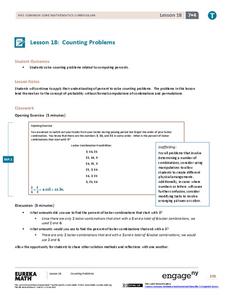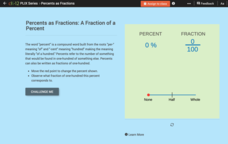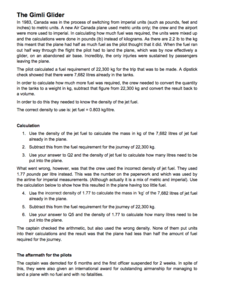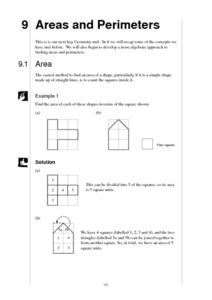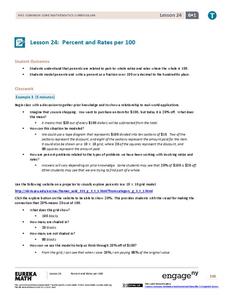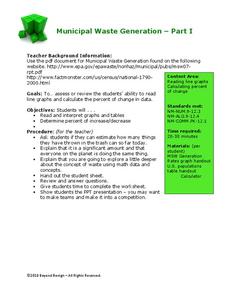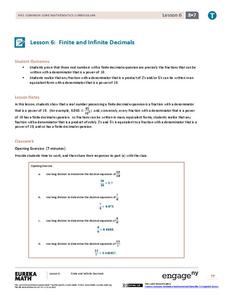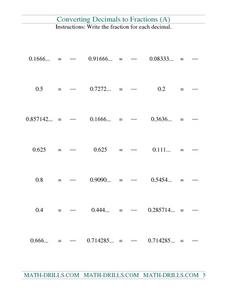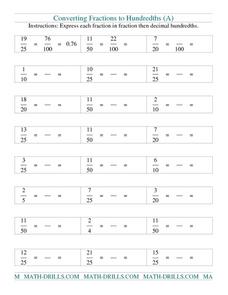EngageNY
Counting Problems
Solving these percent problems is a matter of counting. Pupils find percents by counting the number of events that meet the criteria and the total number of possibilities. Participants create the ratio and convert it to a percent to...
CK-12 Foundation
Percents as Fractions: A Fraction of a Percent
Five questions make up an interactive all about percents and fractions. Mathematicians answer multiple-choice and fill in the blank problems with help from a tool that converts percents to fractions using a sliding bar. An open...
Royal Society of Chemistry
Gimli Glider—Anecdotes for Chemistry Teachers
What's the moral of this story? Units save lives! Teach measurement conversion through storytelling in a quick math-based lesson. Young scientists learn how one country's decision to swap from imperial to metric standard units caused an...
Curated OER
Convert Scientific Notation to Numbers 1
In this scientific notation learning exercise, students convert scientific notation to numbers. Students complete 20 scientific notation problems.
EngageNY
Percent Increase and Decrease
Increase the percent of pupils that are fluent in solving change problems with an activity that asks class members to look at problems that involve either increases or decreases and to express the change in terms of the percent of...
Centre for Innovation in Mamatics Teaching
Areas and Perimeters
Cover some serious area in your geometry curriculum with this collection of worksheets. After first introducing the concept of area using the tiling method, this resource continues on to teach learners how to use...
Polar Trec
Down to the Deep Virtual Lab
At a depth of 3,000 m in the ocean, the pressure is 300 times that at sea level! In the activity, individuals predict what will happen to Styrofoam cups submerged 3,000 meters into the ocean. They then convert these units to soccer...
EngageNY
Percent and Rates per 100
What percentage of your class understands percents? Pupils learn the meaning of percents based upon rates per 100 in the 24th lesson in a series of 29. They represent percents as fractions, decimals, ratios, and models. The scholars...
Beyond Benign
Municipal Waste Generation
Statistically, waste may become a problem in the future if people do not take action. Using their knowledge of statistics and data representation, pupils take a look at the idea of waste generation. The four-part unit has class members...
EngageNY
Curves in the Complex Plane
Go around and around on the complex plane. The sixth lesson in a 23-part unit reviews representing numbers in the complex plane. Pupils graph numbers with equal moduli and notice they represent a circle. They continue to explore complex...
Texas Commission on Environmental Quality
Environmental Sciences
Whether you are teaching environmental science in junior high or studying recycling in kindergarten, there is something for all in this set of lessons designed for environmental education. The 110-page packet comes with tips for...
EngageNY
Finite and Infinite Decimals
Explore the patterns of fractions that produce finite and infinite decimals. The sixth instructional activity of the series asks learners to determine a similar feature of fractions that produce finite decimals. Using the patterns,...
EngageNY
Tax, Commissions, Fees, and Other Real-World Percent Problems
Pupils work several real-world problems that use percents in the 11th portion of a 20-part series. The problems contain percents involved with taxes, commissions, discounts, tips, fees, and interest. Scholars use the equations formed for...
EngageNY
Comparison Shopping—Unit Price and Related Measurement Conversions II
Which rate is greater and by how much? Pupils continue to compare rates to solve problems in the 20th portion of a 29-part series. Rates are presented in a variety of representations either using the same representation or different...
CK-12 Foundation
Division of Fractions: Stacking Berets
Seven questions make up an interactive designed to boost mathematician's skills in dividing whole numbers by mixed fractions. Practice comes with a visual aid with movable parts. Questions types include fill in the blank,...
PBS
Twirling in the Breeze
Blow classes away with a hands-on lesson investigating wind speed. Learners use common materials to design and construct anemometers. They then test their anemometers and collect data on the wind speed created by a fan.
Curated OER
Converting Decimals to Fractions (A)
In this converting decimals worksheet, students study the given decimals and then convert the decimals to fractions. Students solve twenty one problems.
Curated OER
Converting Decimals to Fractions (B)
For this converting decimals worksheet, 5th graders study the given decimals and then write the fraction equivalent beside each fraction. Students solve 21 problems.
Curated OER
Converting Meters and Centimeters (A)
In this converting measurements worksheet, students review the meter to centimeter and centimeter to meter conversion rules. Students then convert the given measurements and solve 24 problems.
Curated OER
Converting Fractions to Hundredths (A)
In this converting fractions worksheet, students study each fraction and convert the fraction to show hundredths value place. Students then express the fraction as a decimal in hundredths place. Students solve 21 problems.
Curated OER
Converting Centimeters and Millimeters (B)
In this converting measurements worksheet, students review the measurement conversions for centimeter to millimeter and millimeter to centimeters. Students solve 24 problems.
Curated OER
Convert Customary Units and Units of Time
In this converting measurements learning exercise, students use the table to solve 6 story problems that require students to convert customary units and units of time.
Curated OER
Converting Decimals to Fractions (3 of 3)
For this decimal conversion worksheet, students use their problem solving skills to convert 18 decimal numbers to fractions or mixed numbers in lowest terms.
Curated OER
Converting Fractions to Hundredths (B)
In this converting fractions activity, students study the given fraction and express the fraction in hundredths value place. Students then express the fraction in decimal hundredths. Students solve 21 problems.
